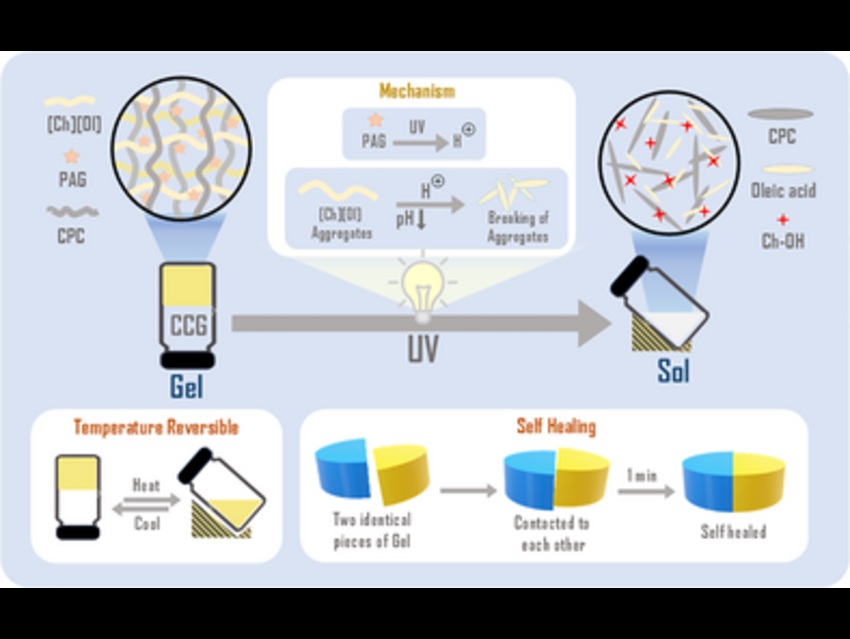Smart gels that respond to light often require complex synthesis, limiting their practical use. Naved Malek, Sardar Vallabhbhai National Institute of Technology, Surat, India, and collaeagues have developed a gel system that combines photoresponsiveness, temperature sensitivity, and self-healing ability using common, easily available components. Its simplicity and multifunctionality make it a strong candidate for applications in soft robotics, sensors, and controlled release systems.
The gel system, called CCG (CPC/[Ch][Ol]-based gel), was formed by mixing cetylpyridinium chloride (CPC); a surfactant [Ch][Ol]; a surface-active ionic liquid (SAIL); and diphenyliodonium nitrate (DPIN), a photoacid generator (PAG). At optimized concentrations (10% CPC, 5% [Ch][Ol], 30 mM DPIN), the components self-assembled into a gel through hydrogen bonding, electrostatic, and hydrophobic interactions.When exposed to UV light (270 nm), DPIN released protons, causing the pH to drop from 7.0 to 4.5. This protonation turned [Ch][Ol] into oleic acid, breaking apart the gel network and causing the gel to permanently liquefy (an irreversible sol transition).
Small-angle neutron scattering (SANS) confirmed structural changes from a mixed network to ellipsoidal micelles. Fourier-transform infrared spectroscopy (FTIR) showed molecular shifts consistent with protonation. Temperature sweeps revealed reversible gel-to-sol transitions, i.e., the gel liquefied at 50 °C and reformed at 25 °C. Rheological tests showed consistent viscosity changes across multiple heating-cooling cycles and a modulus crossover at 46 °C.
Self-healing was demonstrated by joining colored gel halves, which reconnected within minutes. Thixotropic tests showed recovery of mechanical strength after repeated strain cycles, with a healing efficiency of 94.9%. The CCG system thus offers a simple route to design smart materials that respond to light and temperature and repair themselves after damage. While the UV-triggered change is irreversible, this feature suits one-time applications such as drug release or temporary structural changes. Future work could explore reversible photoresponsive systems or biocompatible variants for medical use.
- Photoinduced pH-responsive smart gel based on surface active ionic liquid with tunable and self-healing properties
Tapas Patel, Ravi Pansuriya, Sugam Kumar, Vinod K Aswal, Anugya Bhatt, Naresh Kasoju, Imran Khan, Naved Malek
ChemistrySelect 2025
https://doi.org/10.1002/slct.202502110




![Diazine-Tetraphenylethylene Cyclo[6]arenes for Molecular Recognition in Solution and Aggregate States](https://www.chemistryviews.org/wp-content/uploads/2025/11/ChemistryViews-2.70171-125x94.png)